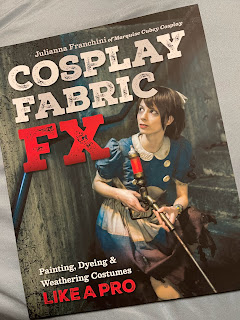Book review: Cosplay Fabric FX 👍👍
I unreservedly recommend Jennifer Franchini's Cosplay Fabric FX: Painting, Dyeing, & Weathering Costumes Like a Pro. This book, lavishly illustrated with full-color photographs and illustrations, is fantastic, full of great information and technique documentation, advice on approaching the aging of costumes, and excellent safety precautions.
The author has a background in costume for film/theatre, and many of the references, media, and techniques she documents in the book are industry standard-practice and probably some that once were closely-guarded "trade secrets," prior to the advent of the internet.
Franchini structures the book in four parts: planning, dyeing, destruction (aka weathering, aging, or distressing), and painting. She's writing with a cosplay production paradigm in mind but the information is fantastic for theatrical/film costume makers (the perspective from which I'm writing this review) as well. It's great to have an applicable reference for costumers that's more recently published than the go-to text Fabric Painting & Dyeing for the Theatre by Deborah Dryden, which was first published in 1981 and now out of print.
I admit that safe work practice is often where my concerns lie with resources written primarily for the cosplay audience--because these books are often not brought out by textbook/reference publishers, it's often obvious that no industrial safety officer or health inspector has been consulted on the safe use of methods and media covered. And in adding those books to my professional library at the studio, I consult them with the same inquisitive perspective that I do old trade manuals that predate OSHA and recommend practices like "rinse your felt hat in gasoline." Some of the techniques are great, but how can I adapt them to safety requirements of my employer.
Franchini opens the book with a section on safety and it's fantastic to see a reference aimed at the cosplay community that mentions the existence of Safety Data Sheets, how to read them and interpret them, and what kinds of PPE to consider.
The inclusion of basic color theory explanations and charts are helpful for novices and a great refresher for those with prior experience in costume painting/dyeing. The chapter on dyeing contains good, accurate information about the dyeing process without an exhaustive amount of information on that extremely complex topic--those with an interest in textile dyeing can literally delve so deep in that subject as to pursue a PhD, but such depth is unnecessary for most costume applications. Franchini covers enough ground to make it clear that not all desired outcomes are possible on all textiles, and to at least give the reader a bit of insight into WHY you can't dye a polyester jumpsuit deep black with Rit in a washing machine.
The chapter on distressing documents many techniques that have previously largely been taught in apprenticeship situations--aging a costume in a way that survives the cleaning process and doesn't actually damage the piece to render it unwearable. I admit to a frustration with a costume/cosplay aging resources out there on YouTube/TikTok where people advocate methods like running over garments with vehicles or wearing them while rolling around in mud. Those methods forfeit control over the outcome and are not durable or repeatable. This book offers better options.
The section on costume painting is also excellent, from its introduction to the various products available on the market today, to the techniques one might use to create stains, toning, and emphasis of topography.
In conclusion, while I won't stop using the Dryden text as a reference (until the reputedly-forthcoming updated edition comes out), this new title by Franchini is an invaluable contemporary supplement, and an excellent reference for cosplayer and other costumers wanting to learn more about these processes.



Comments
Post a Comment